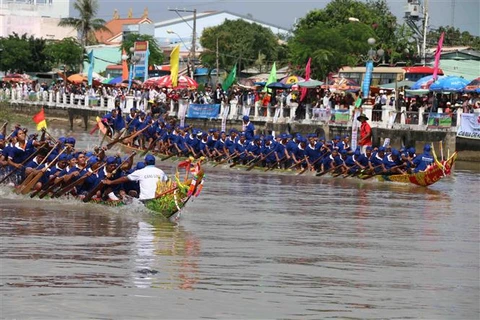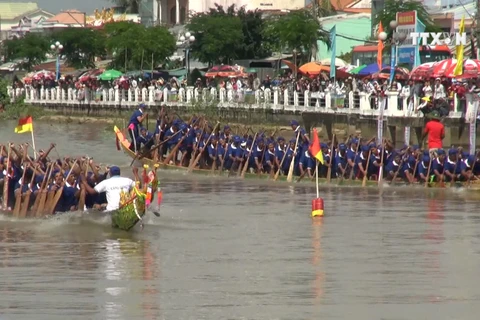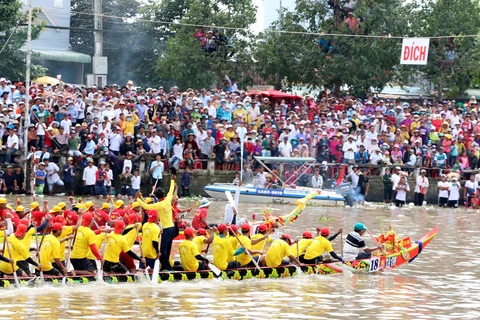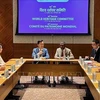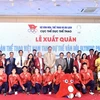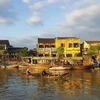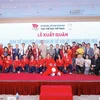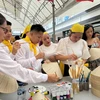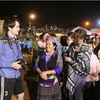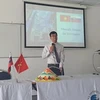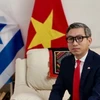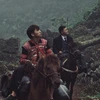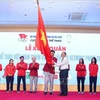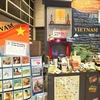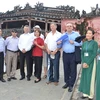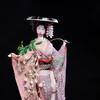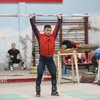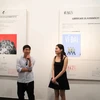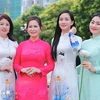 The Ngo boat race is an enticing cultural activity of the Khmer ethnic minority people. (Photo: VNA)
The Ngo boat race is an enticing cultural activity of the Khmer ethnic minority people. (Photo: VNA) Hanoi (VNA) – The recent recognition of the Khmer ethnic minority people’s Ngo boat race in the Mekong Delta province of Soc Trang as a national intangible heritage is expected to assist the community in maintaining and promoting their unique cultural tradition.
The race is the most enticing part of the Ook Om Bok – also called the Festival of Worshipping the Moon, which is one of the three biggest Khmer events, alongside the traditional New Year Festival Chol Chnam Thmay and the Sene Dolta, for remembering ancestors.
Racing activities take place on both land and water, with the latter being a magnet for both local residents and tourists.
Ngo boats (Ghe Ngo) are considered sacred objects to the ethnic Khmer people. The special boat is made of wood by Khmer Buddhist monks, representing one or more Khmer villages. It is decorated with images of dragons, tigers, elephants, lions and peacocks to show its power. Victory in the race means honour to the pagoda and the locality it represents.
In the past, the boat was a canoe, made by hollowing out a large and long tree trunk. However nowadays it is very difficult to find a suitable trunk, so Khmer people make Ngo boats by joining planks together.
With a shape like a snake, boats are about 25 to 30m in length, and both ends are bent. Each vessel must accommodate between 40 to 60 racers. No matter how many people are aboard, each boat has three leaders – one sitting at the bow in charge of spiritual and technical activities; the other two sitting in the middle and at the stern to blow their whistles encouraging the racers and correct their technique.
Each boat has a specific symbol that is related to a destination or a tradition of a pagoda. The symbol represents an organisation in association with its power.
Another interesting fact about the boat is the spiritual beliefs that go with it. Local people believe that each has its god that generates its power and keeps the entire crew safe during the race.
The boat, considered a sacred object, is only used for racing. Every activity it is involved in needs a prayer ceremony. People often hold ceremonies to ask the wood for its trees to make the boat, to kick off the building of the boat and to mark its completion, among others.
About one week before a race, pagodas, following the tradition, hold a launch ceremony for their boats, which features a special offering named "sla tho" and a tray of fruits, cakes, and food according to the need of each pagoda. The offering is made from a coconut or banana tree trunk, with incense and candles placed on it.
Before and after each race, there is a ceremony with its own regulations on offerings, rites, celebrants, and attendees. For example, in the past, several pagodas did not allow women to approach or step over the top of the boat, as they consider such acts to bring about bad luck. However, this belief has changed significantly. Women now can even be on board to participate in the race.
Ngo boat racing has become a common festival of the three ethnic groups, Kinh, Khmer and Hoa, making the relationship between different ethnic communities in the southwest region increasingly interconnected.
The Khmer people in Soc Trang organise the race as a good custom and a great festival for everyone to have fun and to join in healthy competition. It constitutes a typical cultural feature of the river region that deserves to be preserved for generations to come./.


